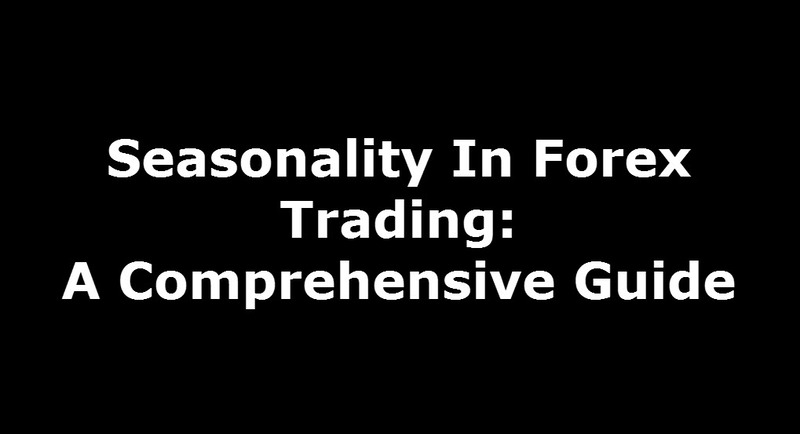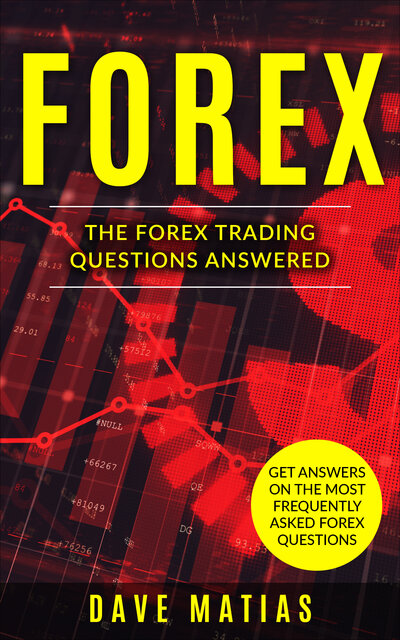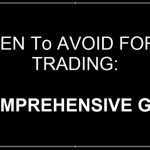Seasonality in Forex is the tendency for certain currency pairs to exhibit consistent patterns at specific times of the year, which is often overlooked in the dynamic Forex market. The FX market is known for its dynamic nature, with prices constantly fluctuating due to various factors such as economic indicators, geopolitical events, and market sentiment.
Understanding these seasonal trends can provide traders with valuable insights into potential market movements and help to make more informed trading decisions. For example, the holiday shopping season in the United States often leads to increased consumer spending, which can impact the value of the US dollar against other currencies.
Forex Seasonal Patterns
Forex seasonal patterns refer to the repetitive, predictable price movements that occur in the currency markets at specific times of the year. As mentioned before, these patterns are driven by a variety of factors, including seasonal changes in supply and demand, economic cycles, and geopolitical events. By understanding these patterns, traders can potentially identify trading opportunities and adjust their strategies accordingly.
One of the most well-known seasonal patterns in forex trading is the “Santa Claus rally.” This phenomenon refers to the tendency for stock markets to rally towards the end of the year, typically in December. This rally is often associated with increased consumer spending during the holiday season and the optimism that comes with a New Year.
In the forex market, the Santa Claus rally can also have an impact, as increased consumer spending can lead to higher demand for certain currencies. For example, currencies of countries that are major exporters of consumer goods, such as the Japanese yen, may see increased demand during this time.
Another seasonal pattern in forex trading is the “summer lull.” This fact refers to the tendency for trading activity to decrease during the summer months, particularly in August. The decrease in activity is often correlated to traders taking vacations and reduced market participation from institutional investors.
During the summer lull, trading volumes can be lower, leading to increased volatility in the markets. Traders should be aware of this seasonal pattern and adjust their trading strategies accordingly to account for potentially increased volatility.
Seasonal patterns can also be influenced by economic cycles. For example, certain currencies may exhibit seasonal strength or weakness based on the economic calendar of their respective countries. For instance, the Australian dollar is often influenced by the country’s agricultural cycle, with the currency typically strengthening during the country’s harvest season.
Geopolitical events can also influence seasonal patterns in the forex market. For example, elections in major economies can lead to increased volatility and uncertainty, which can impact the value of their respective currencies.
Here’s a detailed look at how election years in the U.S. can affect FX trading, along with hypothetical examples:
Increased Volatility: Election years are often characterized by increased volatility in currency markets. This volatility can be driven by uncertainty surrounding the election outcome, with the potential policy changes that may materialize from the event.
Example: In the lead-up to a closely contested presidential election in the United States, the US dollar may experience increased volatility as traders speculate on the potential outcomes and their impact on economic policy.
Policy Uncertainty: Elections can lead to changes in economic policy, which can impact currency values. For example, a change in government may lead to changes in fiscal or monetary policy that can affect interest rates and inflation, which in turn can impact currency values.
Example: If a new government in a country with a history of fiscal stimulus announces plans for increased government spending, this could lead to expectations of higher inflation and potentially weaken the currency.
Safe-Haven Flows: During times of political uncertainty, investors may flock to safe-haven currencies such as the US dollar, Swiss franc, or Japanese yen. This can lead to strength in these currencies relative to others.
Example: In the run-up to a contentious election in a major European country, investors may sell the Euro and buy the Swiss franc as a protective asset, leading to a strengthening of the Swiss franc.
Regional Considerations: Elections in one country can also impact currencies in neighboring countries or regions. For example, political instability in a major trading partner can spill over and affect the currency of a neighboring country.
Example: A presidential election in Brazil could impact the currencies of other countries in South America as investors assess the potential political impact of the election on regional trade and economic stability.
Longer-Term Trends: While elections can introduce short-term volatility, they may also lead to longer-term trends in currency markets.
Example: If a new government in a country with a history of fiscal prudence is elected and implements policies that are seen as favorable to business and investment, this could lead to a prolonged period of currency strength.
In conclusion, election years can introduce significant uncertainty and volatility to currency markets. Traders should be aware of the potential impact of elections on currency values and adjust their trading strategies accordingly to manage risk effectively.
Forex Seasonality Charts & Historical Analysis of Forex Seasonality
To understand the impact of seasonality on forex markets, it is helpful to look at historical data. The historical analysis can reveal patterns and trends that may not be immediately apparent from current market conditions. For example, historical data may show that certain currency pairs tend to perform better during specific months while others may exhibit more volatility.
One common approach to analyzing forex seasonality is to use charts that display historical price data over a long period, such as several years. These charts can help identify recurring patterns and trends in the market that may be related to seasonal factors.
Here are several key aspects of forex seasonality charts and historical analysis that traders should consider:
Identifying Seasonal Patterns: The first step in analyzing forex seasonality is to identify seasonal patterns in the market. That can be done by examining historical price data for a particular currency pair over several years and looking for recurring patterns or trends that occur at the same time each year.
Example: By analyzing historical data for the EUR/USD pair, a trader may notice that the pair tends to weaken in August, possibly due to reduced market liquidity during the summer holiday season in Europe.
Analyzing Historical Data: Once seasonal patterns have been identified, traders can analyze historical data to gain a better understanding of the factors driving these patterns. The analysis may involve examining economic data releases, geopolitical events, and other factors influencing currency prices during certain times of the year.
Example: A trader analyzing the historical data for the GBP/USD pair may find that the pair tends to strengthen in December, possibly due to increased consumer spending during the holiday season in the UK.
Using Seasonality Charts: Seasonality charts are a useful trading tool for visualizing seasonal patterns in the forex market. These charts typically display historical price data for a currency pair over a long period with seasonal patterns highlighted.
Example: A seasonality chart for the USD/JPY pair may show that the pair tends to weaken in March, possibly due to the repatriation of money flows as Japanese corporations bring home overseas profits at the end of the fiscal year.
Incorporating Seasonality into Trading Strategies: Once seasonal patterns have been identified and analyzed, traders can incorporate this information into their trading strategies. This action may involve adjusting trading positions or timing trades to take advantage of seasonal trends in the market.
Example: A trader may decide to reduce their exposure to the AUD/USD pair in April, based on historical data showing that the pair tends to weaken during this time due to seasonal factors.

Factors Influencing Forex Seasonality
Several factors can influence seasonality in the forex markets. Economic indicators, such as GDP growth, inflation rates, and employment figures, can all impact the value of a country’s currency.
Geopolitical events, such as elections or wars, can also have a significant impact on currency values. Additionally, central bank policies, such as interest rate changes or quantitative easing programs, can influence currency values and seasonal trends.
Economic Indicators: Various economic indicators play a crucial role in determining the seasonality of forex markets. GDP growth is a key indicator, as it reflects the overall economic health of a country. Higher GDP growth often leads to a stronger currency, as it indicates a robust Economy.
Inflation rates also affect currency values, as high inflation can erode the purchasing power of a currency, leading to depreciation. Employment figures, such as non-farm payrolls in the US, can impact currency values as well. A strong job market typically strengthens a currency, reflecting economic stability and growth potential.
Geopolitical Events: Geopolitical events can have a significant impact on forex seasonality. Elections, for example, can create uncertainty in the markets, leading to fluctuations in currency values. Political stability or instability can also influence currency values.
Wars or conflicts can disrupt economic activity and trade, leading to currency depreciation. Additionally, trade agreements or disputes between countries can impact currency values as they affect trade flows and Economic relationships.
Central Bank Policies: Central bank policies, such as interest rate changes and quantitative easing programs, are crucial determinants of forex seasonality. Interest rate changes, especially unexpected ones, can lead to sharp movements in currency values.
Higher interest rates attract foreign investment, strengthening the currency. On the other hand, quantitative easing programs, which involve the purchase of government bonds to inject liquidity into the economy, can lead to currency depreciation due to increased money supply.
Market Sentiment and Speculation: Market sentiment and speculation also play a role in forex seasonality. Traders’ perceptions of economic data and events can lead to buying or selling pressure on a currency, impacting its seasonal trends.
For example, if traders believe that a country’s economy is improving, they may buy its currency in anticipation of future gains, leading to a strengthening of the currency.
Natural Disasters and Weather Patterns: Natural disasters and weather patterns can also influence forex seasonality, especially in countries heavily reliant on specific industries. For example, a major hurricane affecting oil production in a country could lead to a decrease in its currency value, as oil exports are a significant source of revenue.
Best and Worst Trading Months in Forex (Generally Speaking)
Based on historical data and analysis, certain months tend to be more favorable for trading, while others may be more challenging.
The concept of the best and worst trading months in Forex is based on historical patterns and market behavior that tend to repeat over time. While these patterns are not guaranteed to occur every year, they can provide valuable insights for traders looking to optimize their trading strategies. Here’s an expanded explanation:
Best Trading Months
February: February can also be a good trading month, as the market continues to adjust to the New Year. Trends that have emerged in January may continue, providing opportunities for traders to capitalize on these trends.
March: March is typically a strong month for trading, as it marks the end of the first quarter of the year. Many companies and institutional investors adjust their portfolios during this time, leading to increased volatility and trading opportunities.
Worst Trading Months
August: August is often considered one of the worst trading months in forex. That is because many traders and institutional investors are on vacation, leading to lower trading volumes and less volatility. The lack of market participants can lead to choppy price action and fewer trading opportunities.
December: December is another month that is considered to be challenging for trading. This notion holds because many traders and institutional investors wind down their trading activities as the year comes to a close. Additionally, the holiday season can lead to lower trading volumes and increased volatility, making trading more unpredictable.
It’s important to note that these patterns are based on historical data and may not hold every year. FX speculators should conduct a thorough analysis and consider current market conditions before making trading decisions.
Additionally, risk management should always be a priority to protect against unexpected market movements. Risk management is the key to being a successful FX trader. Not a lot of forex participants understand this simple statement.
They always think that there is some “magic bullet” or secret ingredient in trading. Things are much simpler than most think – proper (technical; conditional; fundamental) setup with solid risk management = success.
Seasonal Patterns in Major Currency Pairs
Seasonal patterns can vary depending on the currency pair. For example, the EUR/USD pair may exhibit different seasonal trends than the GBP/USD pair. Understanding these patterns can help FX speculators develop more effective trading strategies and manage risk more effectively.
EUR/USD vs. GBP/USD:
The EUR/USD pair is one of the most heavily traded currency pairs in the forex market, representing the Euro against the US dollar. Seasonal patterns in the EUR/USD pair may be influenced by factors such as interest rate decisions by the European Central Bank (ECB) and the Federal Reserve, and economic data releases from the Eurozone and the United States.
The pair may exhibit strength during periods of economic growth in the Eurozone or weakness during periods of political uncertainty.
For example, if historical data shows that the EUR/USD pair tends to strengthen during certain months due to positive economic data from the Eurozone, a trader may consider going long on the pair during those months.
GBP/USD Pair:
The GBP/USD pair, also known as Cable, is another major currency pair that is widely traded. Seasonal patterns in this pair can be influenced by factors such as UK economic data releases and geopolitical events affecting the Eurozone or the US economy. For example, the GBP/USD pair may exhibit increased volatility during major ECB or Fed meetings as traders react to changes in monetary policy.
Other Major Pairs:
Seasonal patterns can also vary for other major currency pairs, such as USD/JPY, USD/CHF, and AUD/USD. These pairs may be driven by factors specific to the countries involved, such as interest rate decisions, economic data releases, and geopolitical events.
Understanding these seasonal patterns can help traders anticipate potential market movements and adjust their trading strategies accordingly. However, it is important to note that past performance is not indicative of future results …“Yes, I always put a disclaimer,” and FX traders should always conduct a thorough analysis and use proper risk management techniques.
Trading Strategies Based on Seasonality
Seasonality can be incorporated into trading strategies in several ways. For example, traders may choose to focus on currency pairs that historically perform well during certain months or they may adjust their trading strategies based on anticipated seasonal trends.
Risk management techniques such as using stop-loss orders or hedging strategies, can also help traders mitigate potential losses during non-typical seasonal periods.

Common Mistakes to Avoid in Seasonal Trading
While seasonality can be a valuable tool for traders, it is important to avoid common mistakes. For example, relying too heavily on seasonal patterns without considering other factors can lead to poor trading decisions. Additionally, failing to adapt to changing market conditions can result in missed opportunities or unexpected losses.
-
Overreliance on Past Performance: One common mistake in seasonal trading is placing too much emphasis on past performance without considering current market conditions. While historical data can provide valuable insights into seasonal trends, it is essential to analyze current economic indicators, geopolitical events, and central bank policies. Market conditions can change, and blindly following past patterns without considering current factors can lead to poor trading decisions.
-
Chasing Trends without Understanding the Cause: Sometimes traders may observe a seasonal trend and jump into a trade without fully understanding the underlying factors driving that trend. It’s crucial to understand, why a seasonal pattern exists and what fundamental or technical factors contribute to it. Without this understanding, traders may trade based on a superficial pattern that could quickly reverse, leading to losses.
-
Ignoring Risk Management: Another mistake is ignoring risk management principles when trading seasonally. Seasonal trends can be powerful, but they are not guaranteed. Traders should always use proper risk management techniques, such as setting stop-loss orders and limiting the size of each trade relative to their overall capital. Ignoring risk management can lead to significant losses, especially if a seasonal trend does not materialize as expected.
-
Failing to Diversify: Failing to diversify is a common mistake in seasonal trading. Traders may focus too heavily on one seasonal trend or one currency pair, exposing themselves to unnecessary risk. Diversification involves spreading investments across different assets or markets to reduce risk. By diversifying, traders can mitigate the impact of unexpected events or trends that affect a particular currency pair or seasonal trade.
-
Failing to Adapt to Changing Market Conditions: Market conditions can change rapidly, and seasonal patterns that were reliable in the past may no longer hold. Traders who fail to adapt to changing market conditions and continue to trade based on outdated seasonal patterns may find themselves on the wrong side of the trade. It’s important to continuously reassess seasonal trends and adjust trading strategies accordingly to account for changing market dynamics.
Overall, avoiding these common mistakes involves conducting thorough research, staying informed about current market conditions, using proper risk management techniques, and diversifying investments. By doing so, traders can increase their chances of success in seasonal trading.
Tools and Resources for Analyzing Forex Seasonality
Several tools and resources are available to help traders analyze forex seasonality. These include software programs that track seasonal trends, as well as websites that provide historical data and analysis. By using these tools effectively, traders can gain valuable insights into potential seasonal trends and make more informed trading decisions.
https://stockcharts.com/freecharts/seasonality
Conclusion
In conclusion, seasonality plays a significant role in the forex markets, influencing currency values and trading patterns at certain times of the year. By understanding these seasonal trends and incorporating them into their trading strategies, currency traders can potentially improve their trading performance and mitigate risk.
Overall, understanding seasonal patterns in the forex market can be a valuable tool for traders. By identifying these patterns and adjusting their strategies accordingly, traders can potentially improve their trading performance and capitalize on seasonal trading opportunities.
At the same time, it is important to remember that seasonality is just one factor to consider when trading forex, and traders should always conduct thorough research and analysis before making any trading decisions.





